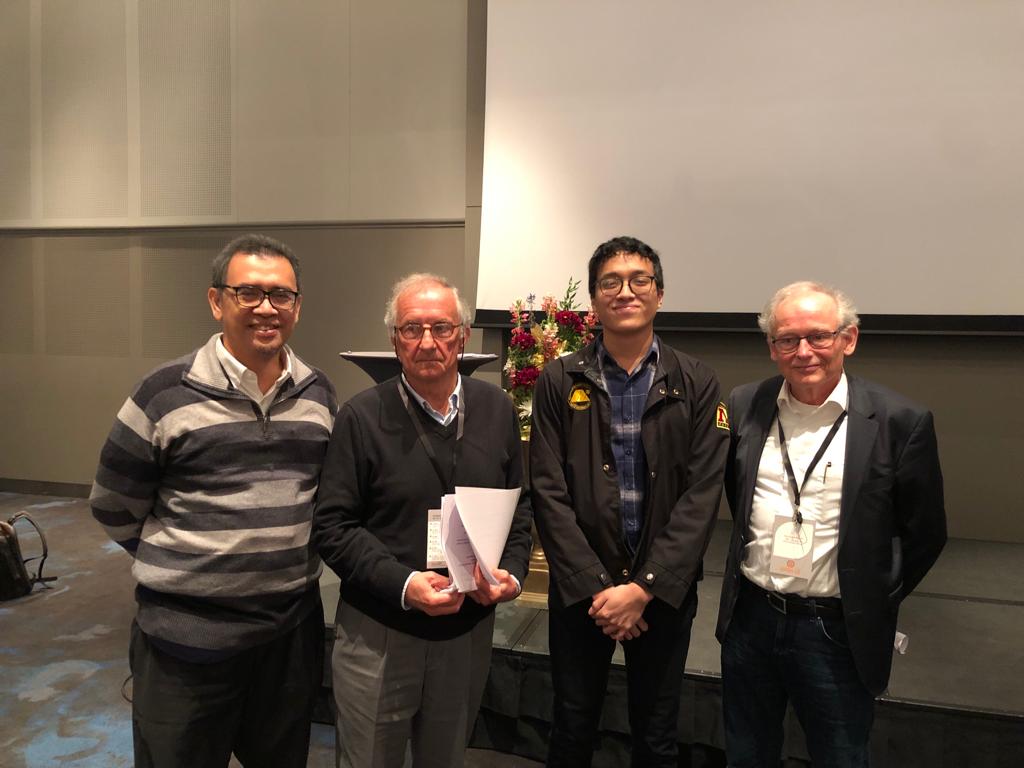Peatland fires caught the attention of Bintang Farhan Muhammad, a student of the Mechanical Engineering Study Program, Faculty of Engineering, Universitas Indonesia (FTUI) class 2017, to be the object of his research. This research led him to win the Best Student Presenter award at the 10th International Seminar on Fire and Explosion Hazard ( ISFEH 10). Apart from him, the same award was also given to two students from Ghent University, Belgium, and Ulster University, UK. ISFEH 10 was held in Oslo, Norway on 22-27 May 2022 and was attended by 56 presenters from all over the world — three of them from UI.
At ISFEH 10, Bintang Farhan Muhammad – currently completing his study from FTUI – presented a paper entitled “Estimation of Smoldering Peat Fire CO and CO2 Emission Factors by Multidimensional Spread and Elemental Variables”. This paper focuses on the estimation of CO and CO2 emissions in peat fires. Bintang conducted research with a team under the guidance of Prof. Ir. Yulianto S. Nugroho, M.Sc., Ph.D., Professor of the Department of Mechanical Engineering, and then the results are written in a scientific article co-written with Hafizha Mulyasih and Dr. Ing. Ridho Irwansyah.
Based on data from the United Nations in 2017, peatland fires in Equatorial Asia (tropical region) also contribute to global carbon emissions. The emergence of the El Niño phenomenon in these areas also exacerbates fire conditions. This phenomenon, which is an anomaly of high sea surface temperatures, causes unusually warmer and drier conditions in fire-prone areas around the world including peatlands.
“Fire on peatlands releases gas and smoke emissions that cause social, health, economic and environmental losses. In this study, Bintang, Hafizha, and the team tried to use an integrated method to get the Emission Factor (EF) value using a Buoyancy Calorimeter. EF describes the number of pollutants released into the atmosphere from forest fires, including smoldering fires that occur on peatlands,” said Prof. Yulianto who is also an FTUI expert in the field of Fire Safety Engineering.
In their research, Bintang and his team tried to minimize the uncertainty caused by variations in the chemical composition of peat as well as the uncertainty caused by one-dimensional estimation (using satellite imagery). “From the research results, it is known that for peat samples from different lands there are differences in the chemical composition of peat. Samples taken from peatlands in Jambi have a different composition from samples from peatlands in Papua or Palangkaraya (Central Kalimantan). Meanwhile, remote imaging using satellites, which has been used to estimate the area of burned peatlands, has limitations because it only displays surface images and does not directly measure the depth of the fire impact (burned depth) on peatlands,” said Bintang.
The results of his research lead to three things, namely the EF value can be obtained from the results of laboratory experiments through analysis of the burned depth pattern and peatland environmental variables. Second, environmental variables and peat characteristics are important elements in the estimation of EF. And finally, it is proven that the calculation of the EF value is not valid if it only includes the variable area of the burned area.
The Dean of FTUI, Prof. Dr. Heri Hermansyah, ST. M.Eng., IPU said, “Hopefully the research conducted by Bintang and his team can provide input for the prevention and management of peatland fires in Indonesia which keep repeating itself every year. Of course, the research carried out can continue to be developed in the future by expanding the boundaries of research in other peatland areas in Indonesia.”
The UI delegation also presented two other papers at ISFEH 10 entitled “Fire Behavior of Aluminum Composite Panel Material Using Small Scale Test Method” by Viliasio Sirait and Reza Adyanto, and “Laboratory Scale Experiment of Vegation Uprooting Phenomena During Smoldering of Peat”, by Jeihan Kartika Hapsari.
ISFEH is an international seminar that has been routinely held every three years by the fire safety research community since 1995 as a forum to share research on the physical effects of hazards, consequences prediction methods, applied safety analysis methods, mitigation methods, emergency response strategies, and many other topics. ISFEH 10 is the first International Seminar in the field of Fire Science to be held again offline (in person), since the Covid 19 pandemic in early 2020.
ISFEH 10 was attended by students of various levels, researchers and professors from Europe, America, Asia and Oceania, and Africa, presenting 60 papers and 17 posters which were divided into sessions on Fire dynamics, Fire Safety Engineering, Hydrogen Safety, Dust Explosion, Battery Safety, Deflagration and Detonations, Fire Safety, Material Behavior in Fires, Explosion Hazards, and Wildfires. The seminar participants also had the opportunity to visit the IFE Hynor Hydrogen Technology Center and Boat Trip and Dinner at the Fjord around the city of Oslo.
***
Public Communication Bureau
Faculty of Engineering, Universitas Indonesia

